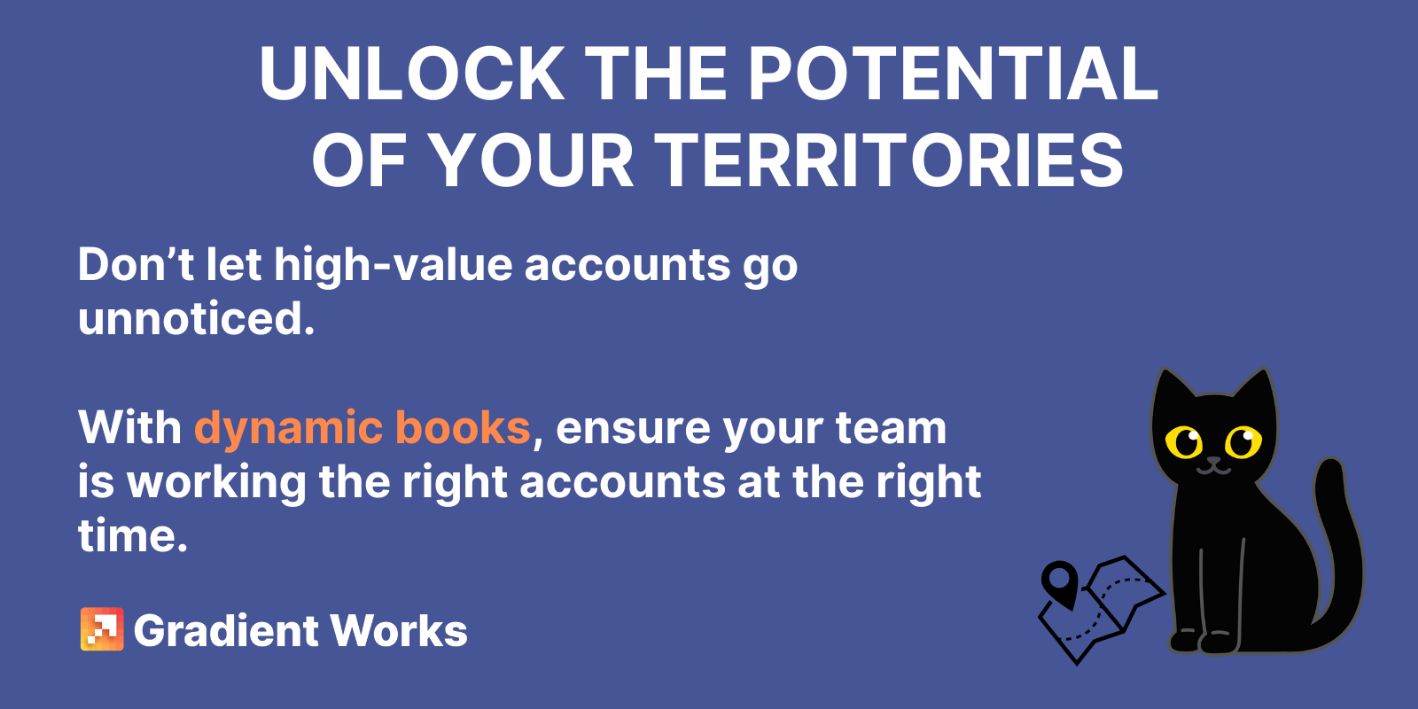Note: This blog post was originally published on 1/18/2024 and updated on 1/28/2025.
Normally, we spend most of our time here talking about dynamic books and how it's a superior replacement (for most companies) for static territories or round robin distribution. However, it's Q1 - or just about to be - for most B2B SaaS companies and your plans are probably set for the year. Now might not be the best time to make a big change like the switch the dynamic books.
But let's say you're curious about the core principles behind dynamic books. You don't have to change your entirely GTM model to implement some of these ideas. And it's okay if you just rolled out new territories and comp plans - you can implement these ideas now without any disruption to your new plan.
So what are some of the core principles of dynamic books that any sales team can implement? Most of them are about focus. The best sales teams are ruthlessly focused on taking the right actions on the right accounts at the right time. Those teams do things like:
-
Define a clear and operationalizable ICP
-
Put the highest potential accounts in front of reps
-
Equip reps to work their accounts well, through enablement and coaching
-
Eliminate distractions like wasteful administrative work and accounts that will never convert
Here are a few ways you can implement stronger focus on your sales team right now.
1. Help reps focus on the right accounts in their territory or book
At the beginning of the year, reps have a book full of accounts they can work. How do they decide which accounts to focus on? What do they use to prioritize outreach?
Some companies use account scores, intent signals, prospect behavior, and other data to help figure out which prospects are most likely to buy now. And those are a great place to start.
But the problem many sales teams are running into is - there is simply not enough good intent to go around. Inbound hand raisers have slowed down, and not as many accounts are showing strong intent.
And really, only companies that have built significant brands and accompanying inbound motions are going to see a lot of value from intent signals. For a lot of companies, especially smaller or earlier ones, intent signals aren't enough to prioritize outreach.
There’s a whole generation of reps who have been trained over the past 5-10 years to be reactive to intent signals and hand raisers, but the reps who will be successful in 2025 have to be proactive.
Reps still have to decide which accounts they want to spend time on. They still have to break into good accounts, to be proactive with the rest of their book. This is a lot to ask, so it's easy to lose focus and just work on the accounts in front of them.
If a sales rep knows exactly which accounts to go after, they can stop using their energy and time contacting accounts that aren't relevant, and instead focus their efforts on accounts that are more likely to yield results, which means more pipeline.
As a sales leader, you can help reps be more systematic in how they proactively work their territory. Reps aren't data scientists (and we shouldn't expect them to be), so we need to help equip reps with everything we can to help them be proactive in working the best possible accounts at all times. That means helping them quickly identify high potential accounts when there aren't many intent signals. It means helping them uncover clusters of similar accounts they can work together to work more efficiently. It may also mean having them return accounts they can't work.
2. Institute an account return policy
One way to help reps focus on the best accounts in their book is to let them return accounts that are currently unworkable.
If an account is unworkable for some reason (more on that in just a second), let a rep take that account out of their name and put it back into a pool for later redistribution or ops review. This way reps aren't forced to hold on to - and get distracted by - unworkable accounts that they can't break into. It also frees up space for reps to receive new, fresh accounts.
What are some reasons reps could return accounts? Most companies use a set of return reasons like this:
-
Duplicate: The account already exists, data needs to be merged with another
-
Get back to me: Currently under contract with a competitor, budget not finalized yet, other timing reasons
-
No ICP fit: The account is in the wrong industry, not the right company size or stage
-
No relevant contact: The account doesn't have anyone in the roles/personas you target
-
Not interested: The prospect said no
-
Out of business: The company shut down or was acquired
-
Bad data: Contact info or company details incorrect
This is a great chance to implement a "get back to me" policy (GBTM). If a rep returns an account, they have to include a GBTM date or otherwise explain why that account should be disqualified or updated.
You may wonder if you should limit the number of account returns per rep. Some managers are concerned that reps will quickly burn through a list of accounts and return them all for a fresh list. We've seen companies limit returns without a GBTM date to a certain number per month. (And if you're worried about how you put a policy like that in place, that's something Gradient Works Bookbuilder can automatically manage.)
3. Identify trending account microsegments
Wouldn’t it be cool to discover trending microsegments in your TAM? Working a set of similar accounts that could be targeted with similar targeted messaging is another way to focus.
Great sales reps have always used new customers to find new similar prospects they can sell to. Closing a great new logo gives a sales rep a new story to tell to new prospects.
Consistently, the most successful outbound strategy is to look at a great existing customer, research the companies that are most similar to them, make sure you have a good profile of what those companies are like, and use targeted messaging to run a play to them. It's focused, relevant outreach. It's also time consuming.
So how can you do something like this at scale with all your reps?
Here's where our Market Map can help.
Market Map identifies high-potential microsegments of prospect accounts that are similar to your best customers. It then create profiles of those segments, with the context reps need for relevant, hypertargeted outreach. From there, you can put those accounts in front of reps (distribute any that aren't already in a rep's book, and flag the ones that are), then track the impact of outreach to this segment.
Relevant outreach is better outreach. Working on a set of similar accounts is more efficient than working on a bunch of unrelated accounts. Even better if that set of similar accounts is similar to a great customer.
We've seen customers use Market Map to create 3-4x more opportunities from a microsegment than they were creating with a standard book of accounts.
Hypertargeting microsegments gives you the ability to scale targeted outreach a little without giving up a lot.
4. Provide reps with the tools they need to work accounts thoroughly
Another way to helps reps focus is to help reps focus. You heard me. I'll explain.
We’re asking so much more of our sales reps right now. They need to self-source more pipeline. They need to close deals in an environment where budgets are tighter and buyers are more demanding. They need to create targeted, personalized outreach. They need to have deals at every stage in the pipeline, and they need to consistency move those deals up.
So it's no wonder that it can be easy for a rep to send a few emails to a prospect, and then stop reaching out after a few non-responses. But you can help reps work prospect accounts more thoroughly. In fact, you may even want to encourage reps to work fewer accounts more deeply. Quality wins out over quantity in outbound right now.
Here's an example. Let's say Rep A uses an automated spray and pray approach driven by AI to send 200 emails a day. Rep B takes a more old-school approach and manually sends 100 emails a day. If they had the same reply rate, then you'd definitely want to take Rep A's approach and send as many emails as you can. But the reality is the spray and pray approach is going to get a lower reply rate - in fact, it'll likely be about half what the manual approach gets.
Rep A sends 200 emails at a 1% reply rate, which is 2 replies. And Rep B sends 100 emails at 2% reply rate, which is also 2 replies. But you burned through 300 accounts for just 4 replies. If you can send half the emails at double the reply rate - and you’re not burning as many accounts - you should definitely choose that approach. Again, quality is going to win out over quantity.
So, what does it mean to thoroughly work an account? How can you focus on quality over quantity. Look at the following?
-
Is a rep focused on the best accounts in their book? What percent of their book are they actively working?
-
Are there high potential accounts they're not working? Why?
-
Are they doing enough touches across enough channels? How many touches, over what timeframe and channels, should they be aiming for?
-
Are multithreading to enough contacts? And are they the right contacts?
-
What does their outreach look like? How is their messaging?
Coach reps on how to work their book for the best outcomes. Don't assume reps know how to multi-thread or how many touches it actually takes to get a response. Help improve their messaging.
And hold reps accountable. Retrieve and redistribute accounts they don't work. Let reps return accounts that are unworkable - but not without capturing a GBTM date. Top off their books with fresh accounts from trending microsegments.
5. Refine your ICP definition and account scoring
Finally, ensure your team is focused on the right kind of customer by clearly defining your ICP (ideal customer profile). How well is your ICP defined? How well have you communicated that to the sales team? How much freedom do they have to prospect outside your ICP?
You likely have some kind of account score that factors in ICP fit. You may use a few basic firmographic datapoints, like a company's employee count or revenue, as well as the location of their headquarters and their industry. You may also look for other signals, like if they have a certain job role on their team, or if they have recently raised funding. That score is likely somewhat correlated to a company's need for your product.
How long has it been since you updated your score? Do you know if your account score is actually correlated to success? Are reps using the score to prioritize outreach? These three questions should guide your next steps, the first of which should be getting satisfactory answers to those questions.
Be sure your whole team is working from the same, updated definition of what your ideal customer is. Anything else is unfocused, wasted effort.
There's more about creating an actionable ICP here if you need to start closer to scratch.
To succeed in 2025, your B2B sales team needs to be laser-focused. Hopefully these tips will help you get there.





